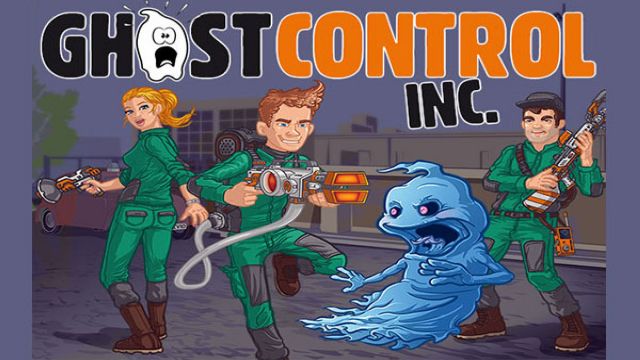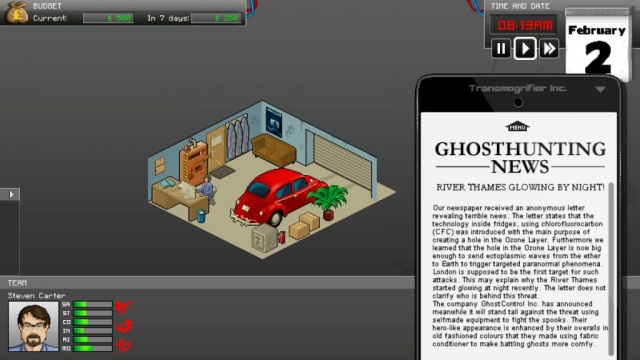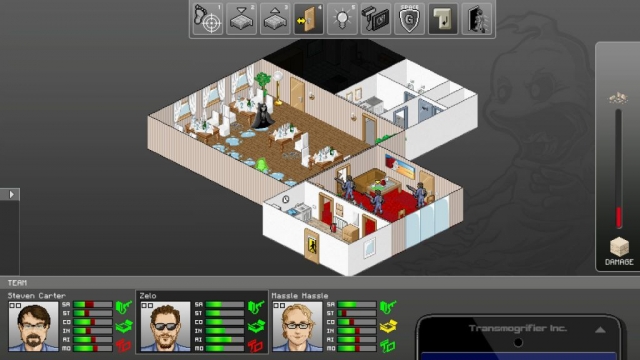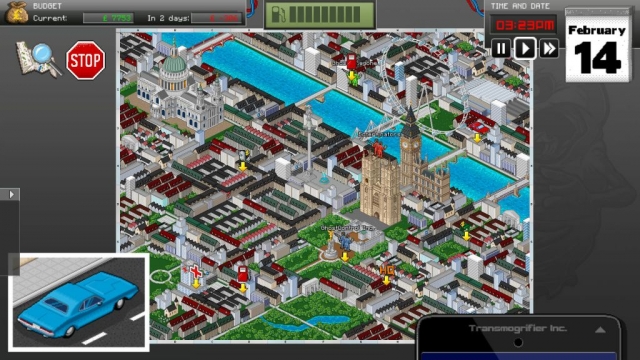GhostControl Inc.

GhostControl Inc. is a turn-based tactical strategy game from German-based Bumblebee Games. It’s sort of a cross of Ghostbusters and X-Com: UFO Defense, only it’s not as funny as the former, and it’s not as compelling as the latter. Still, it’s a budget title, so does it do enough to be worthwhile to play? My inclination is to say “no” but keep reading to see if your answer is the same.
In GhostControl, your objective is to rid London of ghosts and ghost-like entities, including spectres, zombies, skeletons and liches. You begin the game with a single character (you get to pick a face and a name, but your stats are random and you don’t get to see them until you’ve started playing), and right away it’s off to work. You start with a VW Beetle to get around, and your headquarters is nothing more than a dilapidated garage, but from humble beginnings come great things, right?
Probably the first thing you’ll do in the game is hire another hunter. Characters get six attributes: sanity (your “health”), strength (how much you can carry), constitution (how far you can move each turn), intelligence (how good you are with gadgets), aim (how accurate you are with weapons), and morale (how well you can resist fleeing). Attributes range from 0-100, and level 1 characters typically have values in the 30-50 range.
Once you have a team, your next step is to buy some equipment. There are two shops in the game: one sells weapons (to weaken ghosts) and traps (to catch them), and the other sells gadgets (to detect where ghosts are) and clothing (to improve your stats). At the start of the game there isn’t much available, and you have to make do with the likes of jury-rigged vacuum cleaners and simple EMF detectors. There’s also a car dealership for when you want to upgrade from your Beetle.
The missions in GhostControl are random, and they take place in houses, cemeteries, restaurants, subway stations, and more. For each mission you’re tasked with catching 1-6 ghosts. Ghosts come in a variety of shapes and sizes, and they can do things like slime you (which decreases how far you can move each turn), curse you (which decreases all of your attributes), and scare you (which decreases your sanity). To catch a ghost, you have to weaken it with your weapons, and then put a trap down next to it. That means you can’t just stay far away from the ghosts and shoot them; at least one character has to get near them to deploy the trap.
Missions take place in square-gridded environments and proceed in turns. During each turn, you’re allowed to move all of your hunters at the same time. Each hunter gets to perform two actions, which can include firing a weapon, deploying a trap, using a gadget, or walking somewhere. Once you’ve taken your turn, all of the ghosts take their turn, and then everything repeats.
During missions, your hunters gain attribute points based on the commands that you give them. So for example if you order a hunter to shoot, then there’s a chance he’ll gain a point in his aim attribute. Hunters also gain experience and levels, but from what I can tell these doesn’t actually make any difference. Then after the mission, you can send your hunters to a hospital to heal their wounds. This healing is instantaneous, so there isn’t any reason to hire more hunters than you can send on a mission.
The missions generally work well. There’s enough variety to the weapons (some of which can pull or push or stun ghosts) and the ghosts to keep things interesting, and each time you reach a new stage in the game, the ghosts get tougher but better equipment becomes available, and hopefully your hunters have been improving, too. The balance between ghosts and hunters stays pretty even until the end, when the ghosts just get too powerful. Hunters max out at around 100 sanity, but the nastiest ghosts can deal 20-30 damage each turn, and it doesn’t take long for your entire team to panic and flee, or for the mission to become hopeless. During the last stage of the game, I had to flee from about half of the missions, which wasn’t a lot of fun, but at least the game has some challenge to it, and I wasn’t even playing on the toughest difficulty setting.
The basic problem with GhostControl is that there isn’t enough going on. You can upgrade your headquarters, but it doesn’t change anything. You can upgrade your car, but after the Beetle every vehicle only seats three, which is the maximum number of hunters you can take on each mission, meaning that most of the upgrades in this area don’t mean anything, either. There isn’t anything to manufacture or research, you don’t have to defend your headquarters, nobody cares if you abandon or decline a mission, and there isn’t any story. So you just have the random missions, and even with the variety they get repetitive after a while, especially after you’ve seen all of the locations a couple of times.
Beyond the simplicity of the game, the other main issue is the writing, which is generally terrible. Bumblebee apparently doesn’t realize that there are these things called paragraphs you can use to break up walls of text. There are all sorts of typos, including misspellings of “spectre” and “cemetery” that are just unforgivable in a game about the undead. And surprisingly enough nothing is funny. Every so often one of you hunters might say something like “Who let the ghosts out?” or “I’ll show you that Britain’s got talent!” but that’s as close to humor as the game gets.
It took me somewhere around a dozen hours to complete GhostControl Inc. I didn’t hate that time, but I didn’t especially enjoy it, either. What the game did mostly was remind me of just how good X-Com: UFO Defense is. Still, GhostControl can be purchased for under $15, so if it sounds like it might be entertaining to you, it doesn’t require a grand financial investment to try it out.
Reviewed By: Steven Carter
Publisher: Bumblebee Games
Rating: 65%
——————————————————————————–
This review is based on a digital copy of GhostControl Inc. for the PC provided by Bumblebee Games.
 Game Over Online
Game Over Online











